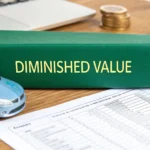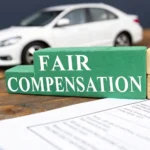Ever wonder why a perfectly repaired car sells for less after an accident? That hidden financial hit is called car accident value loss, or more commonly, diminished value. It’s the immediate and permanent drop in your vehicle’s resale price simply because it now has an accident on its record, and you deserve to be compensated for it.
Understanding Your Car’s Hidden Value Loss
Think of your car’s value this way: before the collision, it had a clean history and a certain market price. After the accident—even with flawless repairs—that history is permanently stained.
When it’s time to sell or trade it in, potential buyers will almost always choose a similar car with no accident history over yours. To compete, you’re forced to accept a lower price. That financial gap is the diminished value you’ve suffered, and it’s real money out of your pocket.
The Three Types of Value Loss
It’s important to know there are different kinds of diminished value, but only one is recoverable from the at-fault driver’s insurance. Understanding these distinctions clarifies what you can actually claim.
| Type of Value Loss | What It Is | Can You Claim It? |
|---|---|---|
| Immediate Diminished Value | The loss in value right after an accident, before any repairs are made. | No, this is a temporary state. |
| Repair-Related Diminished Value | Value lost due to poor-quality repairs (e.g., mismatched paint, cheap parts). | Not from insurance. This is the body shop’s responsibility to fix. |
| Inherent Diminished Value | The loss that remains even after perfect, expert repairs are completed. | Yes. This is the car accident value loss you can and should claim. |
Inherent Diminished Value is what matters for your claim. This is the value that permanently sticks to your vehicle’s history, no matter how great the repairs were, and it’s what you are rightfully owed. Our complete guide on vehicle diminished value explains this concept in more detail.
Why Insurers Don’t Volunteer to Pay for Value Loss, How to Claim Car Accident Value Loss
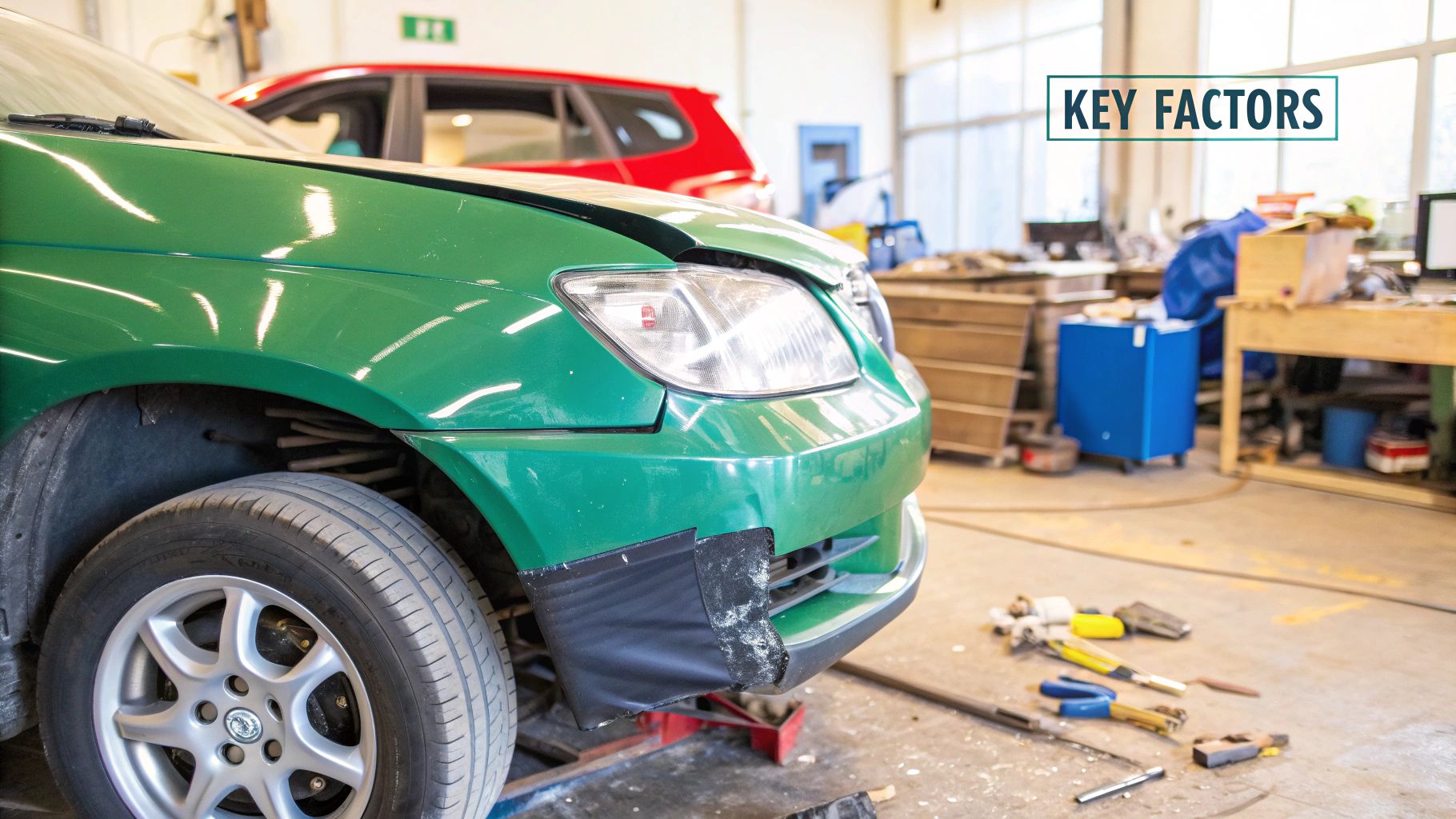
Insurance companies are legally required to pay for repairs that restore your car’s appearance and function. Once your vehicle leaves the body shop, they consider their job done. But this view conveniently ignores the car accident value loss that occurs the moment an accident is recorded on your car’s history report.
The Burden of Proof Is on You
Insurers are well aware of diminished value, but they operate on a simple principle: if you don’t ask for it and prove it, you won’t get it. But How to Claim Car Accident Value Loss? The responsibility falls squarely on your shoulders to demonstrate this loss exists and demand fair compensation. They won’t do the work for you.
In their eyes, your car is “fixed.” But in the real-world market, its value is permanently scarred. It’s up to you to prove that difference and collect what you’re owed.
This is why presenting a solid case is non-negotiable. You can’t just tell an adjuster your car is worth less; you have to show them with undeniable proof. Major insurers have their own internal processes, which makes being prepared even more critical. You can learn more in our guide to handling a State Farm diminished value claim. An independent, certified appraisal from SnapClaim provides the objective, data-driven evidence needed to strengthen your claim and negotiate for the money you are rightfully owed.
Key Factors That Determine Your Car’s Value Loss
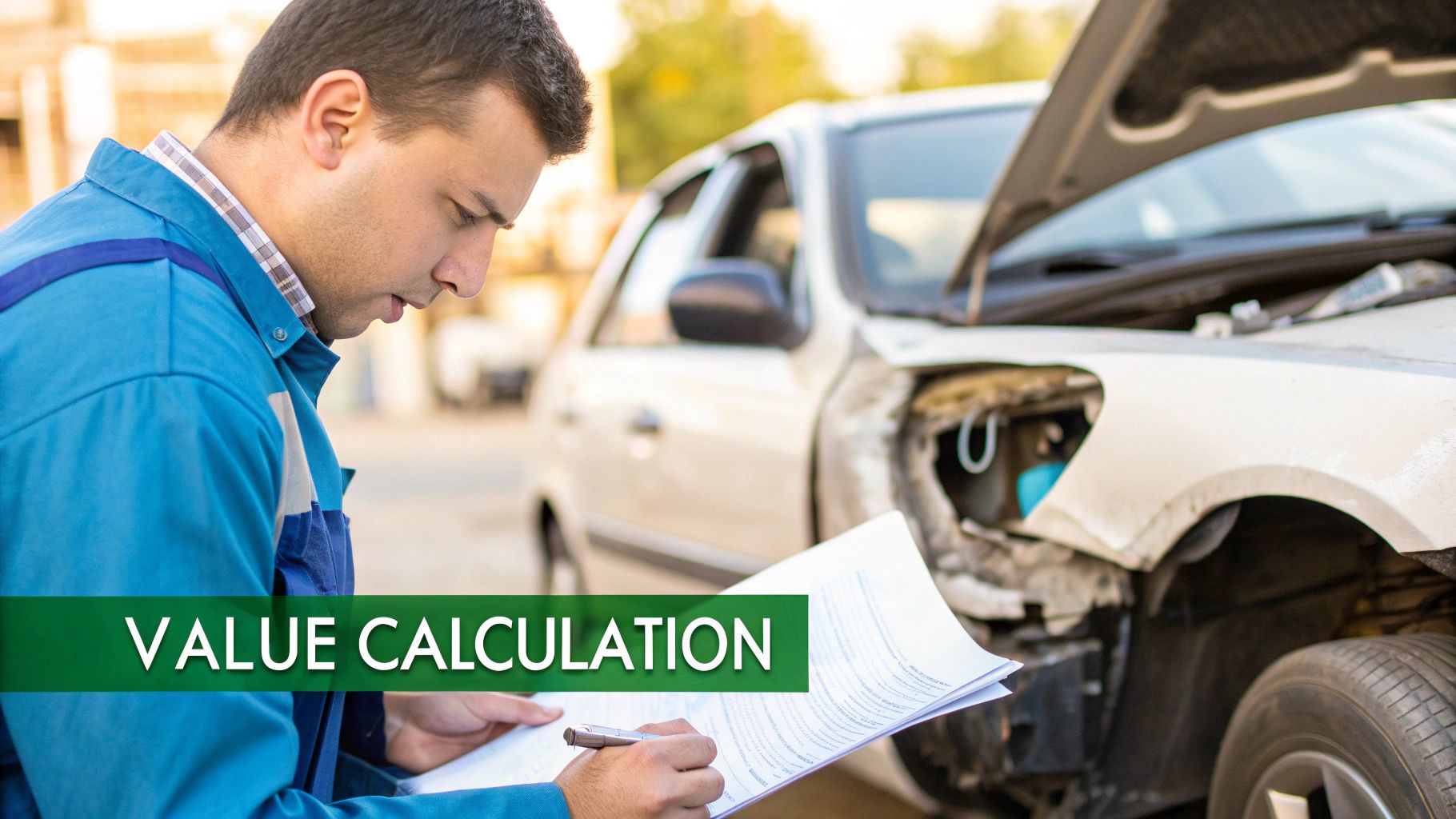
Vehicle Age and Mileage
A newer car with low mileage will suffer a much larger percentage drop in value compared to an older vehicle with over 100,000 miles. An accident on a one-year-old car is a huge red flag for buyers, but on an older car, some history of wear is often expected, so the impact is less severe.
Pre-Accident Condition
The condition of your car before the crash is a major piece of the puzzle. A spotless, well-maintained vehicle has far more value to lose than a car that already had dings, scratches, and a worn interior. An appraiser first establishes the fair market value before the collision to accurately measure the loss.
Severity and Type of Damage
This is arguably the most critical factor. Minor cosmetic issues like a scuffed bumper will cause a small dip in value. However, certain types of damage will significantly harm your car’s worth:
- Structural or Frame Damage: Any damage to the car’s underlying frame raises serious safety and integrity questions, always leading to a severe drop in value.
- Airbag Deployment: When airbags deploy, it signals a major impact, causing the vehicle’s value to plummet.
- Major Component Replacement: Replacing entire doors, quarter panels, or hoods is a much bigger deal than simple dent repair and results in a much greater loss of value.
Understanding how much an accident devalues a car requires looking at all these pieces together.
How to Calculate Diminished Value Correctly
Figuring out the exact dollar amount your car has lost isn’t as simple as using a generic online calculator. Insurance companies often use a flawed formula known as “Rule 17c” to calculate your car accident value loss.
This method is notorious for producing lowball offers that protect the insurer’s bottom line, not your financial interests. It uses arbitrary caps and modifiers that have little to do with what a real buyer would pay for your car on the open market.
The Professional Approach: Market Analysis
The only credible way to calculate diminished value is through a comprehensive market-based analysis. This is what a certified appraiser is trained to do. A professional appraisal involves:
- Establishing Pre-Accident Value: Determining what your exact make, model, and trim was selling for before the accident.
- Gathering Market Data: Contacting dealership managers and other market experts to get real-world feedback on how an accident record impacts the resale price for a vehicle like yours.
- Analyzing Repair Quality: Reviewing the final repair invoice to understand the full scope of the damage.
This evidence-based approach builds a valuation that stands up to an insurer’s scrutiny because it’s rooted in real market behavior. While online tools can offer a rough idea, you can learn more about their limits in our guide comparing the Kelley Blue Book diminished value calculator to professional methods.
An independent appraisal report from a certified expert is the only way to prove your loss with objective, verifiable data. It shifts the negotiation away from the insurer’s self-serving formula toward one based on market facts.
Your Step-By-Step Guide to Filing a Claim
Ready to recover the car accident value loss you’re owed? Once repairs on your vehicle are complete, you can begin the diminished value claim process. Breaking it down into a few clear steps makes it entirely manageable.
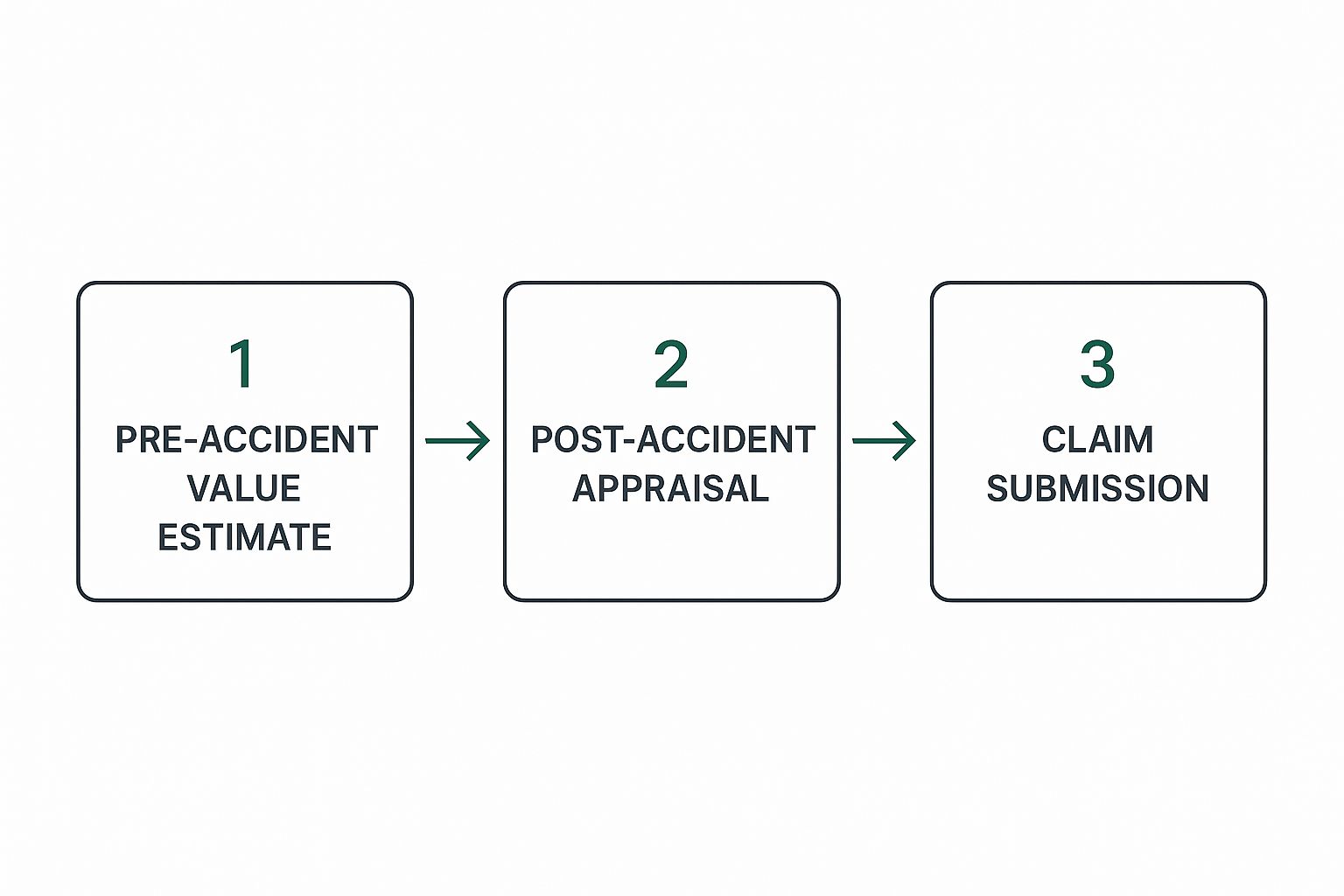
A professional appraisal is the bridge connecting your car’s original value to your final claim. It’s the proof you need.
How to File Your Claim
Follow these steps to build a solid claim. Remember, you typically must be the not-at-fault driver to file a claim against the other party’s insurance.
- Gather Your Documentation: Get your paperwork in order. You’ll need the final, itemized repair bill from the body shop, the official police report, and any photos of the damage.
- Order a Certified Appraisal: This is the most critical step. An independent appraisal from a trusted provider like SnapClaim serves as your objective proof and provides the evidence needed to support your claim.
- Submit a Formal Demand Letter: Draft a professional letter to the at-fault driver’s insurance adjuster stating you are making a claim for your vehicle’s inherent diminished value. Attach your appraisal report and all other documents.
- Negotiate a Fair Settlement: The insurance company will likely return with a lowball offer. Use your appraisal report as leverage to counter their offer and negotiate for the full amount you are owed.
At SnapClaim, we take the risk out of this crucial step. Our money-back guarantee ensures that if your insurance recovery from the claim is less than $1,000, we will fully refund your appraisal fee. This lets you get the proof you need with confidence.
Why a Professional Report Is Your Strongest Tool
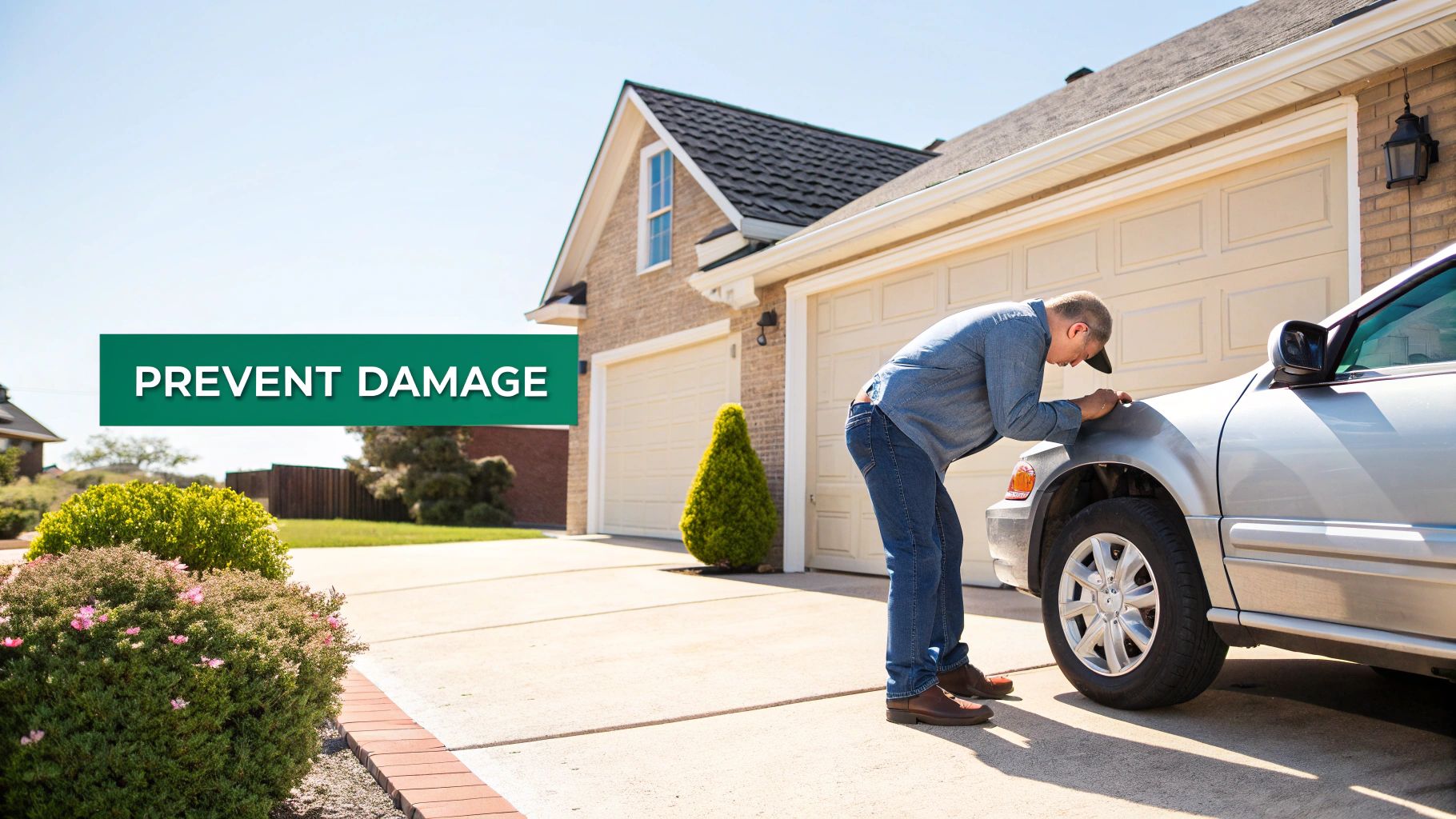
A SnapClaim report is more than just a number; it’s a comprehensive, data-backed document prepared by certified experts who know what insurers need to see.
The Power of Proof
This report provides the specific market analysis and verifiable evidence required to counter lowball offers and prove your claim’s legitimacy. It instantly transforms your request from an opinion into a formal, evidence-based demand that insurers must take seriously.
An independent report shifts the negotiation away from the insurer’s vague formulas and forces them to deal with undeniable market facts. It gives you the leverage to demand what you are rightfully owed.
We make this step risk-free with our money-back guarantee. If the insurance recovery from your claim is less than $1,000, we refund your appraisal fee in full. This commitment means you can confidently obtain the proof needed to secure a fair settlement. The economic costs of motor vehicle crashes are immense, with one estimate from Statista showing a $340 billion impact in a single year. Your diminished value is a real part of that cost, and you deserve to be made whole.
Frequently Asked Questions About Car Accident Value Loss
Here are straightforward answers to common questions vehicle owners have about diminished value claims.
Can I file a claim if I was at fault for the accident?
Generally, no. A diminished value claim is filed against the at-fault driver’s insurance policy (a “third-party claim”). Your own insurance policy is designed to cover repair costs, not the loss of your car’s market value.
How long do I have to file my claim?
This depends on your state’s statute of limitations for property damage, which is a legal deadline. It varies from state to state, so it is best to act quickly to ensure you don’t miss your opportunity to file.
Is it worth filing a claim for an older car?
It depends. For a classic, collectible, or well-maintained luxury vehicle, a diminished value claim can still be significant. For a standard, high-mileage daily driver, the recoverable amount may be small. A free estimate can help you decide if pursuing a full claim makes sense.
What should I do if the insurance company denies my claim?
An initial denial is a common tactic. Don’t give up. The best response is to resubmit your demand professionally, this time including your certified appraisal report. This provides unbiased proof of your loss and forces the insurer to re-evaluate your claim based on facts, not opinions.
About SnapClaim
SnapClaim is a premier provider of expert diminished value and total loss appraisals. Our mission is to equip vehicle owners with clear, data-driven evidence to recover the full financial loss after an accident. Using advanced market analysis and industry expertise, we deliver accurate, defensible reports that help you negotiate confidently with insurance companies.
With a strong commitment to transparency and customer success, SnapClaim streamlines the claim process so you receive the compensation you rightfully deserve. Thousands of reports have been delivered to vehicle owners and law firms nationwide, with an average of $6,000+ in additional recovery per claim.
Why Trust This Guide
This article was reviewed by SnapClaim’s team of certified auto appraisers and claim specialists with years of experience preparing court-ready reports for attorneys and accident victims. Our content is regularly updated to reflect the latest industry practices and insurer guidelines.
Get Started Today
Ready to prove your claim? Generate a free diminished value estimate in minutes and see how much you may be owed.
Get your free estimate today


